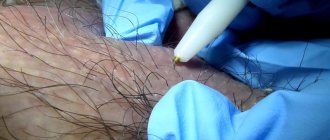Getting rid of excess hair on your body is a natural desire of every representative of the fair sex. For many women, unwanted hair is a real problem. In the modern world, there are many ways for this purpose. According to statistics, 70% of girls mainly choose laser or electrolysis. Each of these hair removal methods has its own characteristics, advantages and disadvantages. Before making a choice, you should figure out what is better: electrolysis or laser hair removal.
What is electrolysis
What is the difference between electrolysis and laser hair removal? This question is asked by all ladies who want to get rid of hair. First of all, you should understand that these are two different procedures aimed at the same result. Electrolysis refers to the removal of hair using a small electrical discharge that is directed directly to the hair root. The micro-discharge current acts on the bulb, burning it. Due to the high temperature, the structure of the bulb is destroyed, as a result of which it dies. The current is delivered to the follicles using tweezers or a game.
It is worth noting that today there are several types of electrolysis, when a thin needle is used as a conductor:
- thermolysis (low voltage alternating current is used);
- blend method (thermolysis heats the bulb, then electrolysis destroys it);
- flash method (follicles are destroyed under the influence of high-frequency direct current);
- galvanic electrolysis (using direct current, the bulb is converted into alkali, after which it is removed along with the hair);
- sequential blend (low current pulses are used);
- sequential flash (unlike the previous method, high-frequency alternating current is used, which significantly speeds up the hair removal process).
Please note that several procedures will be required to completely get rid of excess hair. This is because bulbs have several stages. During the session, only active follicles are destroyed. Some time after electrolysis, new hairs emerge, the hair follicles of which were in a dormant phase at the time of the procedure.
All about the procedure
Each hair on the human body has a growth zone responsible for its maximum length and thickness development. In order to eliminate a hair, you must first damage its follicle. This is achieved by influencing certain factors. However, after exposure to a factor, for example, from an epilator or melted wax, the follicle is gradually restored and the hair begins to grow again.
Hair removal using current allows you to get rid of it where it does not look aesthetically pleasing. This method uses discharges that actively affect the area of the follicles. Thanks to the electric current, the follicular zone is heated to high temperatures and the hair is completely removed.
This way you can remove absolutely all types of hair, both thinning and thick and elastic. That one visit to a cosmetologist will not be enough to completely remove hair in one area or another. After all, more than eighty percent of the hair is usually in the growth stage, the remaining 20% is inactive and grows after some time. Therefore, it may take at least two visits to a cosmetologist to achieve a 100% result.
What is laser hair removal
In this case, hair is removed using laser radiation. It is light with a specific wavelength, high directionality and high energy density.
Please note that the main difference between laser hair removal and electrolysis is that the first method of hair removal is based on the method of selective photothermolysis. Melanin cells (contained in the hair) absorb laser energy, transmitting it in the form of thermal effects to the bulb.
It is important to note that in a woman's body, cells can only absorb light rays of a certain length. Based on this, the destruction of the follicle occurs under the influence of a beam of one length, and the effect on blood hemoglobin when removing capillaries is carried out using a beam of a different light length.
Where do legs grow from?
In fact, everything is simple: the cost of an electrolysis device does not exceed 80,000 rubles (very cool models), laser hair removal devices cannot be purchased for less than 500,000 rubles.
There are 50 times more cosmetologists who can work with electroepilators than laser hair removal specialists (although the picture has been changing recently) - in order to learn how to work with a laser device, you need to undergo training, which costs money and time.
Can you imagine the “lobby” for hair removal using electricity?
But what happens if we compare these two types of hair removal using the same criteria?
Comparisons of laser and electrodepilation
The debate about which is better: electrolysis or laser hair removal has not subsided for many years. However, a laser procedure will rid a woman of unwanted hairs much faster than its main competitor.
Laser hair removal of the armpits is carried out in 5 minutes. Compared to electrolysis, it takes 1 to 3 hours to treat the same area.
It is worth noting that for modern girls with a busy work schedule, this factor is quite significant in choosing electro or laser hair removal. Not all representatives of the fair sex can afford to spend several hours with a cosmetologist.
Exposure to open sunlight
Open sun rays have a negative effect on the skin after radiation treatments. Qualified cosmetologists recommend that sunbathing is prohibited 3 weeks before and after laser hair removal. Failure to comply with this rule can lead to adverse consequences (burns, age spots and other complications).
Electrolysis does not require abstinence from tanning. After the procedure, you can sunbathe 1-2 weeks later. In this case, the timing depends on how quickly the crusts that form after hair removal using this method disappear.
Consequences after the procedure
If the manipulation was performed correctly by a qualified and experienced specialist, the risk of adverse consequences is minimal. However, in some cases, negative consequences may develop:
- Small red spots. This is a normal reaction of the body, they disappear within one to two weeks.
- Shallow scars. If you use a high voltage current without first calculating the current strength, scars may form. Also, scars develop due to improper care after hair removal itself.
- Itching in the area affected by the current. Itching is also a normal reaction of the body, but you should not scratch the skin, this can stimulate the development of an infectious process.
In order to protect yourself from the development of these consequences, you should adhere to a number of rules:
- First of all, immediately after exposure to current, you need to treat the area with a weak alcohol solution or chlorhexidine in a low concentration. To achieve maximum effect, your doctor may recommend treating your skin with calendula infusion at home.
- Within 24 hours after exposure to electric current, you should avoid showering, bathing, and washing.
- Stop using various creams and other cosmetics for a while.
What is the difference between electro- and photoepilation
In addition to the above differences, electric and laser differ in a number of other characteristics that deserve separate consideration.
Price
These hair removal methods differ in cost. The price of one minute of electrolysis costs 8-50 rubles (depending on the area, the qualifications of the cosmetologist, and the reputation of the salon). It is important to note that the first procedure should not last longer than 10-15 minutes. The duration of subsequent sessions depends on the woman’s pain threshold. In 60 minutes, an experienced specialist can thoroughly treat a body part equal to 10 cm2.
The cost of laser hair removal differs from electric hair removal and depends on the number of flashes. Each area of the body requires a different amount of short-term radiation:
- armpits – 20;
- upper lip – 6;
- bikini – 55.
Keep in mind that at one time (1 flash) you can remove hair from an area of 2.5 cm2. The cost of one short-term radiation is 60 rubles.
Required hair length for the procedure
Electrolysis effectively removes hairs up to 3 mm in length. For many, this “condition” becomes a real problem, since it will take some time to grow the hair, otherwise the device will not be able to capture it and completely remove it.
In the case of laser hair removal, the hair should not exceed 2 cm. Immediately 3 days before the procedure, it is necessary to shave the hair from the area where it is planned to permanently get rid of excess hair.
Color of the skin
Electrolysis can be performed on skin of any shade:
- dark;
- white;
- black.
In this case, the differences are that laser hair removal using a ruby laser should not be performed on dark and tanned skin. In this case, the energy of the light pulse will be dissipated. As a result, the bulb will not be properly affected, which will make the procedure ineffective. It is important to note that in this case the woman risks getting burns. However, in modern cosmetology there are a number of other lasers that allow the procedure to be performed on tanned skin:
- alexandrite;
- diode;
- neodymium.
Hair removal color
Electrolysis helps to get rid of hair of any shade, including red and gray hair.
The laser beam is especially effective in the case of dark hair. They contain a large amount of melanin. If the vegetation is poorly pigmented, then it is preferable to pay attention to a neodymium laser.
Electrolysis or photoepilation: which is better and safer?
Both methods do not cause harm to health (in the absence of contraindications) and are completely safe. It is worth noting that in comparison with laser, electrolysis has been used for 40 years. During this time, experts have thoroughly studied its effect on the human body. This method of hair removal has helped hundreds of thousands of women from different parts of the world get rid of unwanted hair.
It is important to understand that both methods do not exclude the possibility of side effects.
To summarize: the differences between laser hair removal and electrolysis
This table of differences will allow you to understand what is better: electrolysis or laser hair removal, and which one is more effective
| Electrolysis | Laser hair removal | |
| Soreness | Belongs to the category of painful procedures. An anesthetic is used. | Included in the group of moderately painful procedures. Pain occurs in sensitive areas of the body (armpits, bikini). |
| Result | If a woman’s hormonal levels are normal, then this method will remove hair 100%. | There is a reduction in hair growth of up to 80%. |
| Skin after the procedure | There is swelling, itching, swelling, and crusting. Any touch to the treated area causes pain. | There is redness, irritation and itching. |
| Possible complications | The appearance of scars, pigmentation disorders in the area of application | Burns, hyperpigmentation. |
| Recommended number of treatments | Complete hair removal requires 3 to 7 procedures. The interval between them is 2 months. | The course consists of 6-10 sessions. The break between procedures must be at least 1 month. |
Modern methods of hair removal by electric current
- Thermolysis. The method is based on the use of current with reduced voltage. The main disadvantage of thermolysis is pain. For this reason, special injections are used for pain relief, since external sprays do not give the desired results. Thermolysis is not used to combat facial hair.
- Electrolysis of galvanic type. Here, the hair follicles are exposed to galvanic current, resulting in the formation of alkali. Around the needle itself, which transmits the electric current, there are sodium ions; when they react with the fluid of the epidermal tissue, they form an alkali. During this reaction, hydrogen bubbles are formed, which are indicators of a successful procedure.
- Bland method. The name itself suggests the idea of combining several methods. This method combines thermolysis and electrolysis. The first stage involves heating the hair follicle using thermolysis. The second stage is hair destruction by electrolysis.
- Sequential blend. This is a kind of subtype of the method described above, which consists of using low amplitude pulses. As a result, pain is reduced.
- Flash method. This is a kind of accelerated thermolysis using frequencies up to 2000 kHz. This can significantly reduce pain.
- Epilation with thread
Contraindications
Like any cosmetic procedure, electrolysis has a number of specific contraindications. The main contraindication is inflammatory reactions, as well as manifestations of infections. Contraindications also include previous diseases of the nervous system and heart. You cannot undergo the procedure if you have neoplasms or during pregnancy. Electrolysis is prohibited for people with endocrine system disorders, epilepsy and mental disorders, and varicose veins. If a lot of toxins have accumulated in the body, oxygen injections will help.
What is better: electrolysis or laser hair removal (pros and cons)
Conclusions about laser hair removal:
- reduces hair growth, but does not remove it permanently;
- effective on dark hair;
- copes poorly with light-colored vegetation;
- Possible adverse effects when exposed to tanned skin;
- procedure time – from 5 minutes;
- the course consists of 7-11 sessions.
Conclusions about electrolysis:
- allows you to permanently get rid of unwanted vegetation;
- the procedure lasts several hours (depending on the area being treated);
- effective on hair of any shade;
- the full course includes 3-6 procedures.
Each method of removing unwanted vegetation actually has both advantages and disadvantages. When comparing laser and electric hair removal, it is recommended to make a choice based on your individual preferences. The most important thing is to pay special attention to choosing a specialist. The effectiveness of the procedure and its safety depend on it. Remember that both laser and electrolysis require highly qualified specialists. Don't neglect hygiene. Make sure everything in the doctor's office is sterile and antiseptics are present. Please note that today many masters work at home, forgetting about sterility, but providing low prices for services. If you want to save money, you must understand that your health and beauty depend on it. Read reviews from other customers. Remember that it is difficult to get to a good specialist. Be patient, because the result is worth it.
Contraindications
Despite a number of differences, laser and electrolysis have a common criterion – contraindications. The procedures are not recommended if the client has:
- varicose veins (in the area affected by the hair removal device);
- malignant neoplasms;
- diabetes mellitus;
- acute viral diseases;
- cardiovascular diseases.
Also, these methods of removing unwanted vegetation are contraindicated for pregnant women.
Read also: IPL and RF hair removal, what are the differences and which method is better?
By comparing which is better, electric or laser hair removal, you can determine which one is right for you. Laser is more effective because it removes hair faster, but it costs more. If you have sensitive, irritation-prone skin and you are afraid of pain, then it is preferable to remove hair with a laser, since such a session is less painful. Immediately before the procedure, you should consult with a cosmetologist who will determine your skin type (skin type) and, if necessary, conduct a test procedure.
Classification
Electrolysis comes in several types. Depending on the type of electrodes used, there are several types of hair removal:
- Tweezers. Each hair is processed separately, and current is supplied to their rods. This is the most painless method, most often it is used for areas with a high level of sensitivity, such as the bikini area, mustache on the face, and so on. The downside is that it takes at least two minutes to destroy one follicle, so the method is not used in areas with dense hair.
- Needle. Here the electrodes have the form of needles with a thickness of no more than 0.1 millimeters, for the manufacture of which gold, nicole, chrome, and so on can be used. The needles can have different thicknesses or be curved. For areas of healthy skin, needles are chosen from special medical metal alloys. For people with a low sensitivity threshold, needles with a special Teflon coating are chosen. For people prone to allergic reactions, gold needles are chosen.











